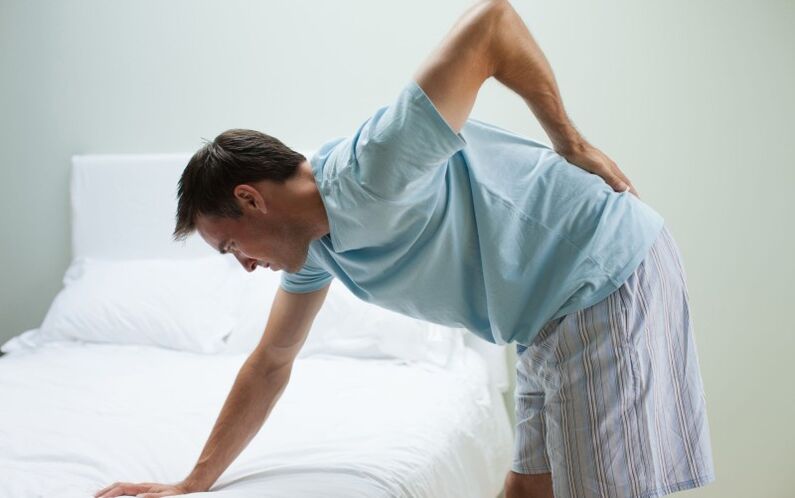In clinical practice, back pain is a relatively common syndrome. It affects the lumbar spine, while the patient feels "girdle" pain. This is how degenerative, musculoskeletal and dystrophic pathologies manifest themselves in the form of osteochondrosis or spondyloarthrosis.
Low back pain - causes and symptoms
In medicine, the causes of lower back pain are traditionally distinguished:
- Infectious and inflammatory processes in the spine;
- Muscle spasms or pinched nerves;
- Intervertebral hernia formation;
- Metastasis of the spinal cord or spine;
- Scoliosis, lordosis, kyphosis;
- Circulatory disorders (with stroke, paralysis);
- Pathology of the gastrointestinal tract (atypical manifestations of inflammatory appendicitis, obstruction of the bile ducts and intestines);
- Diseases of the kidneys, reproductive organs;
- In some cases, during late pregnancy, women may experience discomfort in the lumbar spine.
Low back pain can be acute or persistent (chronic). They can also "travel", i. e. arise in other organs, but give to the lower back.

Acute pain strikes suddenly, it has a piercing character, can impede movement and give to the lower back and hips. The patient has a forced body position and limited mobility.
Acute pain is diagnosed when:
- stretching the long muscles of the back;
- vertebral fractures and protrusions of the intervertebral disc;
- facet syndrome (nerve root clamping, without displacement of the vertebral disc);
- epedural abscess (immediate hospitalization of the patient is required, as there is a high risk of spinal cord compression);
- dystrophic anomalies of the hip joint.
Chronic lower back pain is characterized by loss of sensitivity, "lumbago" in the gluteus muscle, weakness of the lower leg, the formation of bone growth.
Patients may experience postural disturbances, intermittent claudication, deformity of the legs.
Chronic back pain occurs when:
- osteochondrosis;
- ankylosing spondylarthrosis;
- metastatic and intradural tumors.
Diagnosis and treatment of back pain
The exact cause of back pain can be diagnosed with CT (computed tomography), MRI (magnetic resonance imaging), x-ray, or ultrasound of internal organs. The first two methods provide a thorough assessment of the condition of the bones and soft tissues, X-rays show bone integrity and the presence of neoplasms, and ultrasound examination shows disease of its organs and systems.
The therapeutic course is prescribed only by the attending physician, depending on the diagnosis, it may include: taking analgesics, hormone medications, a course of physiotherapy procedures or manual therapy, exercise therapy. If the pain is caused by disc displacement or develops against the background of osteochondrosis, it is effective to wear a rigid fixation corset. It significantly relieves the lumbosacral area, prevents muscle overstrain and the formation of cramps. A good therapeutic effect is given by the restriction - a special injection into the intervertebral joint. They relieve pain and relax muscles.
In severe cases, surgery may be required. It is very important not to self -medicate, but to seek qualified medical help in a timely manner.
During the recovery period, you need to regularly do physiotherapy exercises, undergo massage and physiotherapy courses. This will help relieve muscle tension, increase blood flow, and relieve cramps.
General recommendations for pain in the sacro-lumbar spine:
- pay attention to sleep breaks. In this case, the bed should be with a hard and flat surface. Strictly exclude soft mattresses and bottom.
- wear a support bandage. It is especially important for pregnant women in the third trimester.
- painkillers are allowed.
- rub your back with an ointment with warming and anti-inflammatory components. In any case, you can’t over -cool it; it is best to wear a fur scarf or warm belt during worsening pain.
Low back pain during pregnancy
If we talk about lower back pain during pregnancy, then it is associated with changes in the center of gravity of the female body due to the development and growth of the fetus. Also, as a result of hormonal changes (excessive relaxin production), the hip-sacral joint relaxes, which disrupts balance. The enlarged abdomen and excessive curvature of the spine increase the pressure on the lower back. Muscles are always excessive, which is a major cause of pain.
The risk group included girls who, prior to pregnancy, had problems with hip joint muscle development, impaired posture, osteochondrosis, and spinal pathology of a neurological nature. The painful sensation does not appear earlier than the second trimester, and this is about from the fifth or sixth month. It can be reduced by strengthening the muscles with a special set of exercises. And the sooner you start training your back muscles, the easier it will be to bear a healthy child.



































